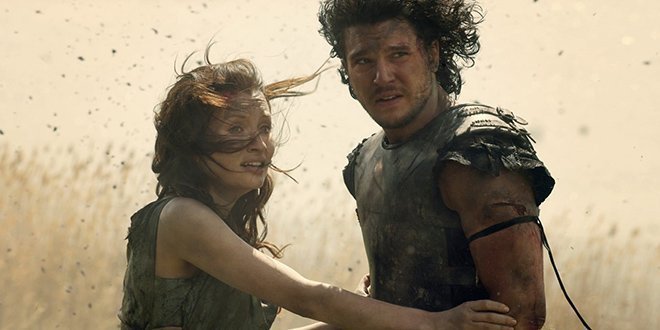What happens when the director of the Resident Evil franchise teams up with the writing team that brought us Batman Forever? You get a film like Pompeii, which aims to tell a story of star-crossed love in the final hours before the eruption of Mount Vesuvius wipes the city off the map. But in order to get to the inevitable destruction, a bit of background information is in order, and we begin 17 years earlier, when a group of Romans led by the ruthless Corvus (Kiefer Sutherland) slaughters a band of Celtic rebels, leaving only a single child behind.
That child is subsequently sold into slavery, and grows up to become a notorious gladiator known only as The Celt (Kit Harington). His skills in the arena find him shackled and shipped off to Pompeii, where he will be forced to compete as part of a celebration to welcome an emissary from Emperor Titus. If you guessed this emissary to be none other than the aforementioned Corvus, responsible for the death of The Celt’s family, then congratulations: you’re already one step ahead of the filmmakers.
The Celt, whose name we eventually learn to be Milo (not that it matters), has a chance encounter with Cassia (Emily Browning), the daughter of a local nobleman (Jared Harris) playing host to the Romans. It seems Cassia has recently returned from Rome to escape the unwanted advances of Corvus (this guy really gets around), but her father’s political aspirations leave him blind to his daughter’s peril. Corvus is willing to make a substantial investment in Pompeii’s future, provided that he be adequately compensated, of course.
Milo forms an unlikely bond with Atticus (Adewale Akinnuoye-Agbaje), Pompeii’s most famous gladiator and his scheduled opponent for the games, and rather than fight to the death for the amusement of the rich and powerful, they band together to wipe out an entire detachment of soldiers, much to the delight of the common folk. This naturally raises the ire of Corvus, but before he can inflict punishment on the rebels, the fireworks begin, and Mount Vesuvius erupts.
The destruction of the city is the high point of the film, and not just because it brings the audience closer to the end credits. The set pieces are hugely elaborate, the visual effects are stunning, and the 3D is used to great effect after having been completely useless up to this point. Milo’s quest to rescue the damsel in distress and avenge the death of his family becomes a race against time as smoke and fire engulf the remains of the city, and the final 30 minutes are undeniably exciting.
Unfortunately, we can’t judge the film based on the third act alone, and it’s impossible to forgive the one-dimensional characters and stilted dialogue that sounds like it was written by Attack of the Clones-era George Lucas. Harington is not a bad actor, as fans of Game of Thrones can certainly attest, but he’s given little more to do than swing weapons and show off his abs. Sutherland’s scenery-chewing performance is probably the most enjoyable in the film, if only for its absolute absurdity.
Once upon a time, Roman Polanski was attached to a version of the Pompeii story, and I would have been curious to see how that turned out. Instead, director Paul W.S. Anderson has given us a confused mess of a film, a destruction porn Gladiator ripoff that carries as much weight and emotion as the ashy remains of the real life inhabitants of the doomed city.




